The latest on the total solar eclipse in Canada
A total solar eclipse fell over parts of eastern and central Canada today, prompting massive crowds to gather in its path for a chance to catch a glimpse of the rare celestial event.
The path of totality – where the moon will fully obscure the sun, causing the skies to darken – first crossed through southwestern Ontario around 3:15 p.m. and moved east through Quebec and Atlantic Canada before exiting Newfoundland around 3:45 p.m. eastern time.
Much of Canada was still be able to witness a partial eclipse. But those gathered along the path of totality, ranging from 164 to 196 kilometres wide, got the full show — depending on the weather.
- Will the weather affect the view of the eclipse? Check out the forecast
- Primer: How to watch the solar eclipse
- Video: How to safely view the eclipse with your kids
- Podcast: What to know ahead of today's total solar eclipse
Find live updates from our reporters below.
NASA’s live broadcast as the total solar eclipse moves across North America
6:25 p.m.
Near Eclipse Island in Newfoundland, the solar eclipse takes on deeper meaning
Burgeo First Nation members gather for a total solar eclipse in Burgeo, Newfoundland, Canada April 8, 2024. Eclipse Island seen in the background was named by Royal Navy explorer Captain James Cook in 1766.Greg Locke/Reuters
On the south coast of Newfoundland, hundreds gathered on a wharf in the town of Burgeo to celebrate an eclipse with a particular historical significance. About 250 feet offshore sits Eclipse Island, where British explorer and cartographer James Cook, known for charting the province, witnessed a solar eclipse on Aug. 5, 1766, and so christened the island.
Under cold clear skies, Melissa Mills, who works for the town, watched the sun meld behind the moon with a rush of amazement.
“I was just thinking about how wild it is – James Cook was here with his small team and writing down what he was seeing and sending it back to England. And here is everyone 250 years later trying to capture it on their iPhones and cameras,” said Ms. Mills.
Burgeo First Nation Chief Elaine Ingram said Mi’kmaq women and children, dressed in regalia that included moose hide shawls and ribbon skirts, drummed and sang the Gathering Song on the wharf overlooking Eclipse Island, where she said arrowheads and ulu knives have been found.
“It was awesome,” she said. “The feeling that we had was bringing us closer, back to our ancestors.”
– Lindsay Jones
5:08 p.m. ET
MPs take in the eclipse as parliamentary activities briefly suspended
Dozens of elected officials, including Conservative Leader Pierre Poilievre, gathered on the Hill to crane their necks skyward to look at the solar eclipse.
The Canadian Press
Not even the vital business of Parliament was enough to keep MPs from slipping outside to glimpse celestial history.
Dozens of elected officials, including Conservative Leader Pierre Poilievre, gathered on the Hill to crane their necks skyward.
As darkness descended, Poilievre — from behind a pair of standard-issue eclipse glasses — described the moment as “surreal.”
Justin Trudeau was spotted taking in the spectacle from the roof of the building that houses the Prime Minister’s Office.
Liberal MP Jaime Battiste called it one of the biggest highlights of his time on the Hill.
Battiste said he found it humbling to imagine people sharing the experience together, regardless of political stripe.
Parliamentary activities were briefly suspended to allow MPs and their staff members to enjoy the partial eclipse.
NDP MP Leah Gazan shared a laugh with fellow parliamentarians Lori Idlout and Jenny Kwan as they watched the moon drift across the sun.
Further down Wellington Street, the foreign interference inquiry also paused briefly to let lawyers, witnesses and journalists could watch the show.
– The Canadian Press
4:59 p.m.
‘It was like the moon ate the sun!’: Thousands gather in Montreal
People watch the moon as it approaches the period of totality during a solar eclipse in Montreal on Monday, April 8, 2024.Evan Buhler�/The Globe and Mail
A cry of anticipation rose from the thousands of people gathered outside the Montreal Science Centre as totality approached. Cirque du Soleil acrobats juggled and performed contortions as the buzz mounted in the early afternoon and visitors began putting on their eclipse glasses and craning their necks skyward. As the moon covered the sun and the total eclipse began, people applauded and shouted with joy.
“It’s so beautiful … Yes, yes!” exclaimed Jérémy Mwalaba, a grade 9 student from Montreal.
Streetlights came on in the Old Port during the totality, adding to the feeling of sudden nighttime. A few stars were visible in the urban sky, with the Montreal skyline as a backdrop.
Afterward, dazed visitors reflected on what they had seen.
“It was like the moon swallowed the sun!” said eight-year-old Charlotte Masounave.
“It was surreal,” said Nick Leduc. “It made me very conscious of the passing of time, because we only had a minute but it was surprising how quickly it passed. It was like a dream.”
Chrystine Bouchard, who came from an hour outside the city with her family, found it beautiful how much the eclipse brought people together and united them in a common experience. “Everyone had the same age and the same heart today,” she said.
– Eric Andrew-Gee
4:45 p.m.
Video: Total eclipse peeks through clouds at Niagara Falls
The total eclipse peeked through clouds over Niagara Falls on Monday to give the huge crowds gathered there a view of the stellar phenomenon.
4:17 p.m.
A once-in-a-lifetime experience in Notre-Dame-des-Bois, Quebec
Thousands of people gathered to observe the eclipse from the Mont-Mégantic provincial park in Notre-Dame-des-Bois, Que., situated along the central path of totality. Others elected to park on a nearby road and watch the phenomenon just outside their cars or out in a field.
Astonished exclamations emanated from the small crowd as darkness covered the landscape, as nothing but the sun’s white crown was left around the moon’s deep black disc.
Among the roadside watchers was Marisela Cerato, who came with her son and daughter from Laval, north of Montreal. She took the day off for the occasion and had no regrets. “I am impressed, really,” she said. She saw a partial eclipse in 2017, but “this was completely different.”
Charles-Antoine Marcotte and Étienne Grenier also took the day off and made the trip from Quebec City by car and road bike. “It’s the first time, and maybe the last,” that they would see a full solar eclipse, Mr. Marcotte said. “We wanted to take advantage of this.”
He said he felt “a lot of emotion during the totality phase. … It was really beautiful. I’d take one a year, I think.”
– Frédérik-Xavier Duhamel
3:52 p.m.
Total solar eclipse exits North America on Newfoundland’s eastern coast
The 2024 total solar eclipse has exited North America after passing through parts of Ontario, Quebec, New Brunswick, Prince Edward Island, Nova Scotia and Newfoundland.
Canadians and visitors gathered in all six provinces to witness the celestial event, which won’t be seen in this country again until 2044.
Eclipse watchers were cast into darkness as the moon moved directly between the sun and earth, giving them a rare chance to see solar flares burst into the cosmos.
Astronomy educator Julie Bolduc-Duval says with so much dividing Earth-bound audiences, the eclipse offers people a chance to come together in the shadow of the moon.
Total solar eclipses have been central to some major scientific breakthroughs, including the detection of helium and support for Einstein’s general theory of relativity.
Statistics Canada says about one in six people live in Canada’s path of totality based on 2021 census data.
– The Canadian Press
3:47 p.m. ET
Totality hits Lake Erie
Relief and elation as totality ended in a brilliant diamond ring north of Lake Erie – a spiky crown around the moon’s black disk with bright red prominences shining like gemstones. A sight to remember!
3:34 p.m.
Totality reaches Kingston, Ont.
Chris Belkosky shows the setup of his Dobsonian telescope, before the start of a total solar eclipse, in Kingston, Ont.Justin Tang/The Canadian Press
The darkness of totality reached Kingston, Ont.
People in Lake Ontario Park began cheering and howling at the eclipse.
The full eclipse lasted four minutes, with people cheering as the sun began shining over the crowd.
Volunteers for the city frantically started telling people to put their glasses back on over a megaphone as the sun began to show itself again.
– The Canadian Press
3:32 p.m.
In Miramichi, N.B., the light dims and ‘Total Eclipse of the Heart’ blasts
At 4:20 p.m. in Miramichi, N.B., the natural light dimmed and eclipse watchers blasted Total Eclipse of the Heart.
“The sun has some red spots and some yellow spots. It looks like an upside down banana,” said Luna O’Brien, 5, of Halifax.
3:20 p.m. ET
Streetlights come on in Toronto
The streetlights came on in downtown Toronto as the moon passed in front of the sun, blocking its light.
Canada’s most populous city is just outside the path of totality.
– The Canadian Press
3:16 p.m.
Total solar eclipse enters Canada
The total solar eclipse has now entered Canada in southwestern Ontario.
This according to the University of Toronto’s Dunlap Institute for Astronomy and Astrophysics.
The solar eclipse’s path of totality will pass through parts of Ontario, Quebec and Atlantic Canada before exiting North America at 3:46 p.m. eastern time.
– The Canadian Press
3:10 p.m.
‘It looks like a crescent moon’
Ainzley Harris, 8, of Miramichi, N.B. at 4:10 p.m. ET: “It looks like a crescent moon.”
3:10 p.m.
Minutes away from a total solar eclipse in Canada
Sun is now fingernail-thin by Lake Erie. We are eight minutes from totality!
3:10 p.m.
When will the total solar eclipse begin in your city? Times for the path of totality

Total eclipse times and durations for
selected Canadian locations
(local times, p.m.)
ONT.
North
100 km
Toronto
Durations
30 seconds
U.S.
Hamilton
1 minute
Windsor
2 minutes
Niagara
Falls
3 minutes
Leamington
3:20
Central line
3:18
3:16
3:14 p.m.
(EDT)
Ottawa
Cornwall
Kingston
3:26
3:24
3:22 p.m.
(EDT)
PARTIAL
TOTAL
DURATION
PARTIAL
ECLIPSE
ECLIPSE
OF
ECLIPSE
BEGINS
BEGINS
TOTALITY
ENDS
Ontario
Leamington
1:58:39
3:13:43
2m 2s
4:28:04
Hamilton
2:03:56
3:18:12
1m 53s
4:31:12
Niagara Falls
2:04:53
3:18:20
3m 30s
4:32:00
Fort Erie
2:04:47
3:18:12
3m 44s
4:32:02
Kingston
2:09:32
3:22:16
3m 2s
4:34:28
Cornwall
2:12:35
3:25:01
2m 11s
4:35:58
North
Quebec
100 km
QUE.
Montreal
Lac-Mégantic
3:32
3:30
3:28 p.m.
(EDT)
PARTIAL
TOTAL
DURATION
PARTIAL
ECLIPSE
ECLIPSE
OF
ECLIPSE
BEGINS
BEGINS
TOTALITY
ENDS
Quebec
Montreal
2:14:29
3:26:55
1m 17s
4:36:52
Drummondville
2:16:07
3:28:32
35s
4:37:40
Sherbrooke
2:16:37
3:27:43
3m 25s
4:38:16
Lac-Mégantic
2:18:01
3:28:47
3m 27s
4:38:58
North
100 km
N.B.
Grand Falls
Les Îles-de-la-Madeleine
4:34 p.m.
(ADT)
4:36
4:40
Tignish
Fredericton
PEI
Moncton
Charlottetown
PARTIAL
TOTAL
DURATION
PARTIAL
ECLIPSE
ECLIPSE
OF
ECLIPSE
BEGINS
BEGINS
TOTALITY
ENDS
New Brunswick
Grand Falls
3:22:45
4:33:06
1m 27s
5:40:49
Hartland
3:22:43
4:32:24
3m 21s
5:43:13
Fredericton
3:23:43
4:33:50
2m 16s
5:41:55
Miramichi
3:25:27
4:34:24
3m 09s
5:42:15
Prince Edward Island
Tignish
3:27:12
4:35:45
3m 11s
5:43:10
Summerside
3:27:23
4:37:08
1m 04s
5:43:32
North
100 km
N.L.
Gander
5:14 p.m.
(NDT)
Bonavista
5:18
Clarenville
Channel-Port
Aux Basques
PARTIAL
TOTAL
DURATION
PARTIAL
ECLIPSE
ECLIPSE
OF
ECLIPSE
BEGINS
BEGINS
TOTALITY
ENDS
Newfoundland and Labrador
Channel-Port
4:02:52
5:09:59
2m 45s
6:15:26
Aux Basques
Gander
4:07:27
5:12:50
2m 13s
6:16:29
Clarenville
4:08:11
5:13:38
2m 31s
6:17:11
Bonavista
4:08:52
5:13:43
2m 53s
6:17:07
MURAT YÜKSELIR / THE GLOBE AND MAIL, SOURCE:
NASA; OPENSTREETMAP; FRED ESPENAK,
RASC OBSERVER’S HANDBOOK

Total eclipse times and durations for
selected Canadian locations
(local times, p.m.)
ONT.
North
100 km
Toronto
Durations
30 seconds
U.S.
Hamilton
1 minute
Windsor
2 minutes
Niagara
Falls
3 minutes
Leamington
3:20
Central line
3:18
3:16
3:14 p.m.
(EDT)
Ottawa
Cornwall
Kingston
3:26
3:24
3:22 p.m.
(EDT)
PARTIAL
TOTAL
DURATION
PARTIAL
ECLIPSE
ECLIPSE
OF
ECLIPSE
BEGINS
BEGINS
TOTALITY
ENDS
Ontario
Leamington
1:58:39
3:13:43
2m 2s
4:28:04
Hamilton
2:03:56
3:18:12
1m 53s
4:31:12
Niagara Falls
2:04:53
3:18:20
3m 30s
4:32:00
Fort Erie
2:04:47
3:18:12
3m 44s
4:32:02
Kingston
2:09:32
3:22:16
3m 2s
4:34:28
Cornwall
2:12:35
3:25:01
2m 11s
4:35:58
North
Quebec
100 km
QUE.
Montreal
Lac-Mégantic
3:32
3:30
3:28 p.m.
(EDT)
PARTIAL
TOTAL
DURATION
PARTIAL
ECLIPSE
ECLIPSE
OF
ECLIPSE
BEGINS
BEGINS
TOTALITY
ENDS
Quebec
Montreal
2:14:29
3:26:55
1m 17s
4:36:52
Drummondville
2:16:07
3:28:32
35s
4:37:40
Sherbrooke
2:16:37
3:27:43
3m 25s
4:38:16
Lac-Mégantic
2:18:01
3:28:47
3m 27s
4:38:58
North
100 km
N.B.
Grand Falls
Les Îles-de-la-Madeleine
4:34 p.m.
(ADT)
4:36
4:40
Tignish
Fredericton
PEI
Moncton
Charlottetown
PARTIAL
TOTAL
DURATION
PARTIAL
ECLIPSE
ECLIPSE
OF
ECLIPSE
BEGINS
BEGINS
TOTALITY
ENDS
New Brunswick
Grand Falls
3:22:45
4:33:06
1m 27s
5:40:49
Hartland
3:22:43
4:32:24
3m 21s
5:43:13
Fredericton
3:23:43
4:33:50
2m 16s
5:41:55
Miramichi
3:25:27
4:34:24
3m 09s
5:42:15
Prince Edward Island
Tignish
3:27:12
4:35:45
3m 11s
5:43:10
Summerside
3:27:23
4:37:08
1m 04s
5:43:32
North
100 km
N.L.
Gander
5:14 p.m.
(NDT)
Bonavista
5:18
Clarenville
Channel-Port
Aux Basques
PARTIAL
TOTAL
DURATION
PARTIAL
ECLIPSE
ECLIPSE
OF
ECLIPSE
BEGINS
BEGINS
TOTALITY
ENDS
Newfoundland and Labrador
Channel-Port
4:02:52
5:09:59
2m 45s
6:15:26
Aux Basques
Gander
4:07:27
5:12:50
2m 13s
6:16:29
Clarenville
4:08:11
5:13:38
2m 31s
6:17:11
Bonavista
4:08:52
5:13:43
2m 53s
6:17:07
MURAT YÜKSELIR / THE GLOBE AND MAIL, SOURCE:
NASA; OPENSTREETMAP; FRED ESPENAK,
RASC OBSERVER’S HANDBOOK
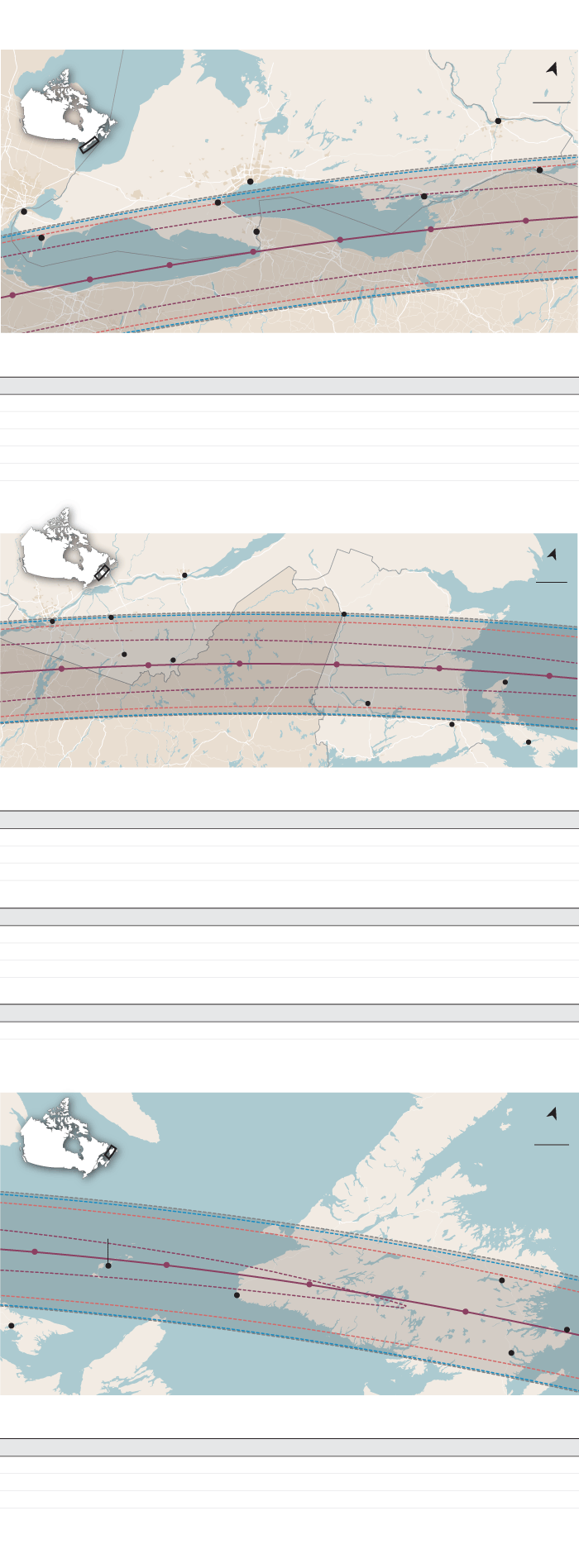
Total eclipse times and durations for selected Canadian locations
(local times, p.m.)
North
50 km
CANADA
Ottawa
ONT.
Cornwall
Toronto
Durations
30 seconds
U.S.
Kingston
1 minute
Hamilton
Windsor
2 minutes
3 minutes
3:26
Niagara Falls
Leamington
3:24
3:22
3:20
Central line
3:18
3:16
3:14 p.m.
(EDT)
PARTIAL
TOTAL
PARTIAL
ECLIPSE
ECLIPSE
DURATION OF
ECLIPSE
BEGINS
BEGINS
TOTALITY
ENDS
Ontario
Leamington
1:58:39
3:13:43
2m 2s
4:28:04
Hamilton
2:03:56
3:18:12
1m 53s
4:31:12
Niagara Falls
2:04:53
3:18:20
3m 30s
4:32:00
Fort Erie
2:04:47
3:18:12
3m 44s
4:32:02
Kingston
2:09:32
3:22:16
3m 2s
4:34:28
Cornwall
2:12:35
3:25:01
2m 11s
4:35:58
North
Quebec
50 km
QUE.
N.B.
Montreal
Grand
Falls
Drummondville
Lac-Mégantic
Sherbrooke
3:32
4:34 p.m.
(AST)
3:30
4:36
3:28 p.m.
(EDT)
Tignish
Fredericton
PEI
Moncton
Charlottetown
PARTIAL
TOTAL
PARTIAL
ECLIPSE
ECLIPSE
DURATION OF
ECLIPSE
BEGINS
BEGINS
TOTALITY
ENDS
Quebec
Montreal
2:14:29
3:26:55
1m 17s
4:36:52
Drummondville
2:16:07
3:28:32
35s
4:37:40
Sherbrooke
2:16:37
3:27:43
3m 25s
4:38:16
Lac-Mégantic
2:18:01
3:28:47
3m 27s
4:38:58
New Brunswick
Grand Falls
3:22:45
4:33:06
1m 27s
5:40:49
Hartland
3:22:43
4:32:24
3m 21s
5:43:13
Fredericton
3:23:43
4:33:50
2m 16s
5:41:55
Miramichi
3:25:27
4:34:24
3m 09s
5:42:15
Prince Edward Island
Tignish
3:27:12
4:35:45
3m 11s
5:43:10
Summerside
3:27:23
4:37:08
1m 04s
5:43:32
North
50 km
Les Îles-de-la-Madeleine
4:40 p.m.
(ADT)
4:42
N.L.
Gander
5:14 p.m.
(NDT)
Channel-Port
aux Basques
5:18
Charlottetown
Bonavista
Clarenville
N.S.
PARTIAL
TOTAL
PARTIAL
ECLIPSE
ECLIPSE
DURATION OF
ECLIPSE
BEGINS
BEGINS
TOTALITY
ENDS
Newfoundland and Labrador
Channel-Port Aux Basques
4:02:52
5:09:59
2m 45s
6:15:26
Gander
4:07:27
5:12:50
2m 13s
6:16:29
Clarenville
4:08:11
5:13:38
2m 31s
6:17:11
Bonavista
4:08:52
5:13:43
2m 53s
6:17:07
MURAT YÜKSELIR / THE GLOBE AND MAIL, SOURCE: NASA; OPENSTREETMAP; FRED ESPENAK, RASC OBSERVER’S HANDBOOK
3:07 p.m.
Totality closes in Outside Nanticoke, Ont.
Outside Nanticoke, Ont., the clouds are mostly gone and totality is closing in.
3:05 p.m.
Families picnic while awaiting eclipse in Miramichi, N.B.: ‘We’re just super excited’
In Miramichi, N.B., on the path of totality, families picnicked under clear blue skies while awaiting the eclipse. Dominque Beaulieu took the afternoon off work to view it with her husband and two kids. They sat in the back of their van munching on Tim Hortons sandwiches.
“We’re just super excited. Now that we’re in the perfect location to have 100-per-cent totality, it’s going to be pretty cool,” Ms. Beaulieu said.
Her husband, Andre Guy Rouselle, added, “Everything is lining up.”
3:02 p.m. ET
Families visit Montreal Science Centre to see eclipse: ‘It’s a once-in-a-lifetime event for the kids’
Antonio Cinquino and Grace Petrucci brought their young daughters Myka and Kassia to the Montreal Science Centre to view the eclipse, joining tens of thousands of other visitors. They just got a telescope for Christmas and have a budding interest in space.
“It’s a once-in-a-lifetime event for the kids,” Mr. Cinquino said.
Laura Girardi got on the metro, where there were endless queues to buy tickets until officials simply opened the turnstiles. Train after train was packed with eclipse watchers heading downtown to witness the spectacle, leaving anxious astronomy buffs stranded on the platform.
“I’m into aliens and the supernatural,” Ms. Girardi said, before quipping, “Maybe this’ll be their time to invade!”
Robin Potvin came from Rouyn-Noranda in Northern Quebec to see the eclipse (and his daughter, who lives in Montreal). He remembers cutting holes in a shoebox to witness a partial eclipse as a boy in 1972.
“It was unforgettable,” he said.
2:51 p.m.
Hundreds gather for an eclipse tailgate party in Miramichi, N.B.
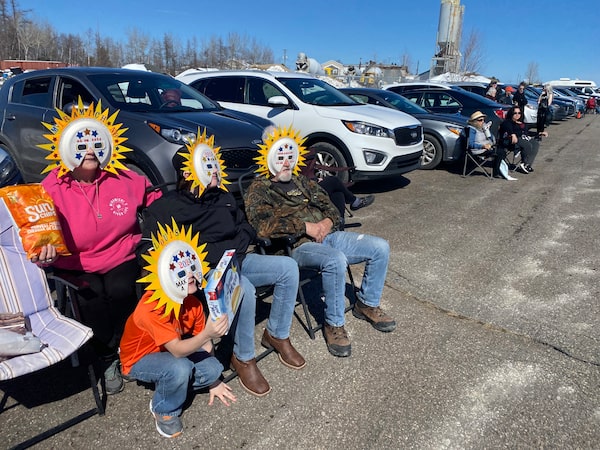
Hundreds gathered for a tailgate eclipse party at the airport in Miramichi, N.B., which is on the eclipse path of totality.Lindsay Jones/The Globe and Mail
Hundreds gathered for an eclipse tailgate party at the airport in Miramichi, N.B., which is on the path of totality. Under clear blue skies, families sat in the trunks of their vehicles eating sandwiches, chatted in camping chairs and set up telescopes, while kids blew bubbles and parents lectured them about keeping their eclipse glasses on.
Dan Black of Halifax, who travelled to Tennessee to view an eclipse in 2017, felt lucky to have one of the best views on the continent with his telescope, just a few hours’ drive from home.
“It’s different than the last time because this is like a star party,” he said.
Karen Donovan and her family crafted sun-themed masks with attached eclipse glasses for the event, bringing sun- and moon-themed snacks such as Sun Chips, Half Moon cakes and Sunny D beverages to celebrate the event.
“It’s cool,” said her grandson Louis Donovan, 7, who said he was excited to be missing school and hanging out with his family.
2:48 p.m.
The views from Port Dover, Ont.
On the road to Port Dover the clouds are breaking up. On front porches and farmhouse steps, families are gathered and looking up.
2:46 p.m.
Many travel far and wide to see eclipse in Quebec’s Eastern Townships
In La Patrie, a village east of Sherbrooke, Cécile Poisson sat on her sunny porch, enjoying a glass of pinot noir with friends ahead of the eclipse. “It’s a wine for all occasions,” she said.
Others had to travel further. Shashindra Kumar Dhanapal and his brother, Ravindra, both engineers, made the long trip from Waterloo and Windsor, Ont., to have the best possible eclipse experience.
“I’m into science,” Ravindra said to explain the spontaneous decision to take two days off work and drive hours east. The brothers joined dozens of families having picnics in a La Patrie park on the side of a hill.
They plan to visit Montreal on the way back, as it’s Shashindra’s first time in Quebec.
2:35 p.m.
View of the total eclipse from Mexico
Mazatlan, Mexico was the first place in North America to see Monday's total eclipse as it began to sweep across the continent. Solar flares were visible around the shadow cast by the moon during totality.
2:31 p.m.
Authorities estimate Niagara Falls crowds fall well short of expected one-million visitors
A woman adjusts her camera to photograph the total solar eclipse in Niagara Falls, Ont.Aaron Lynett/The Canadian Press
Authorities had estimated that a million people would flock to Niagara Falls for a glimpse of the eclipse. By 2 p.m., the crowds appeared to fall well short of forecasts. “It’s a little slow, actually,” said local busker James Knight, glancing down roughly $5 worth of coins in his guitar bag.
The grey skies and the local state of emergency declared to prepare for an onslaught of tourists likely had something to do with the lack of customers, he said. “I think it scared everyone off.”
Asked if he had a particular song chosen to play during the totality, Mr. Knight smiled and launched into a rendition of Bad Moon Rising.
2:25 p.m.
Heavy traffic in Montreal as crowds gather to watch eclipse
People gather to watch the total solar eclipse at Parc Jean Drapeau, in Montreal.Ryan Remiorz/The Canadian Press
Traffic is heavy around Montreal, particularly heading toward the Eastern Townships, where the total eclipse will last the longest.
Cameras show traffic moving at a crawl on Highway 10 east of Montreal, and a Transport Quebec official says some routes are more congested than usual.
The city’s subway system is also crowded, particularly heading to the station at Parc Jean-Drapeau on the former Expo 67 site, where hordes have gathered to watch the eclipse.
– The Canadian Press
2:13 p.m.
Partial solar eclipse begins in Canada
The partial solar eclipse is now visible in parts of Canada. It has begun in Dunnville, Ont., visible through a break in the clouds!
It’s set to cross into totality at about 3:12 p.m., starting in Southwestern Ontario before moving through Quebec and Atlantic Canada.
It will exit Newfoundland at about 3:45 p.m.
– Ivan Semeniuk and The Canadian Press
1:50 p.m.
Eclipse watchers break Guinness World Record
Some of the 309 people gathered to break the Guinness World Record for the largest group of people dressed as the sun pose on a sightseeing boat in Niagara Falls.Jenna Zucker/Reuters
Eclipse watchers in Niagara Falls, Ont. broke a Guinness World Record for the largest group of people dressed as the sun. Over 300 people dressed up, participants had to be wearing black, yellow or white pants.
Officials say it’s a fun way to celebrate the solar eclipse — which will be on full view in the border community.
– The Canadian Press
1:40 p.m.
Notable eclipse social media posts
– Globe staff
1:35 p.m.
Hopes are high that clouds could break in Ontario
Hopes are mounting along Ontario’s scenic Erie Shore. East of Port Colborne there are some breaks in the ceiling of low clouds.
Further west observers are reporting sunny skies.
1:15 p.m.
Beach city Mazatlan, Mexico is first up for an eclipse view
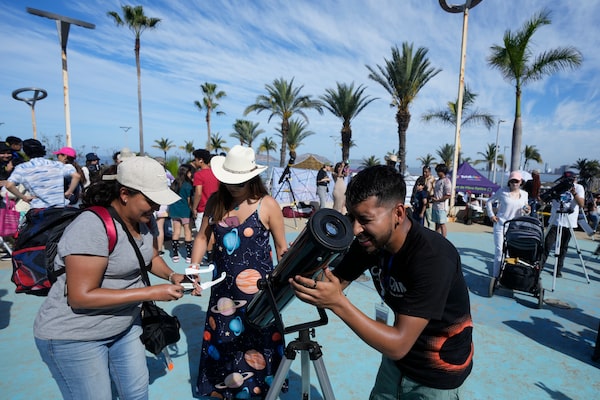
Amateur astronomers prepare to watch a total solar eclipse in Mazatlan, Mexico, Monday, April 8, 2024.Fernando Llano/The Associated Press
Extending five hours from the first bite out of the sun to the last, Monday’s eclipse begins in the Pacific and makes landfall at Mazatlan, Mexico, before moving into Texas, Oklahoma, Arkansas and 12 other U.S. states in the Midwest, Middle Atlantic and New England, and then Canada. Last stop: Newfoundland, with the eclipse ending in the North Atlantic.
Valeria Rosas says her four kids had been so excited by an October partial solar eclipse that passed over southeast Mexico, that she decided to come to this Pacific coast beach city for Monday’s total eclipse.
The 32-year-old drove eight hours from Leon, Guanajuato, with 10 friends and relatives.
They joined hundreds of others in a beachside park under blue skies streaked with wispy clouds. It’s the first part of North America that will get to see the total eclipse.
Rosas’ mother, Carmen Loza Rodríguez, recalled that Rosas was a baby when Mexico last saw a total solar eclipse in 1991.
“How cool that we have the opportunity to experience it in this digital age, that we can share it with the world,” Rosas said.
– The Associated Press
1 p.m.
Amateur astronomers set up for the eclipse in Sherbrooke, Que.
In Sherbrooke, Que., amateur astronomers had already erected a small forest of telescopes and oversized camera lenses by noon, their families having lunch on folding chairs next to the equipment in Quintal Park.
“There are a lot of passionate people, they came to set up early,” said Jasmin Robert, general director of the Federation of Amateur Astronomers of Quebec, who will witness his first total eclipse. The event was limited to 400 people – members and their relatives – but the federation also holds events in southern Quebec for the broader public.
Stéphane Dubois, who recently retired from the Canadian Armed Forces, has just started to chase eclipses. “We were supposed to go to Texas, but when we saw that in Sherbrooke the sky would be ideal for all North America, we cancelled the trip and came here,” he said. Virtually no cloud could be seen in the skies of the Eastern Townships in the early afternoon Monday.
Mr. Dubois and his wife, France Ouellet, came from Gatineau and plan to travel around the eclipse schedule. “In the next few years, it’s a project. I will focus on the trip, and he will appreciate the eclipse pictures,” Ms. Ouellet said as her husband was making final adjustments on two cameras and a telescope, all pointed at the sun.
12:25 p.m.
How to protect your eyes during the solar eclipse
It is never safe to look at the sun unprotected. This is true even when most of the sun’s surface is hidden, such as during a deep partial eclipse. Regular sunglasses, no matter how dark, do not provide sufficient protection from infrared solar rays that can cause permanent damage to the retina. To ensure safe viewing, the Canadian Association of Optometrists advises using solar eclipse glasses that meet the international standard ISO 12312-2. These should be ordered from a reputable supplier well before the event. The American Astronomical society has compiled a list of suppliers, including some that are based in Canada.
If you are using eclipse glasses, be sure they are not scratched or damaged. Do not use glasses with binoculars or telescopes, which require their own specialized solar filters.

Solar eclipse safety
Never observe the sun...
...directly
...through
binoculars, cameras,
smartphones
or telescopes
...through
coloured
plastic or
glass
....through
sunglasses
...in a reflective
surface like a
mirror, water
or chrome
...through a
film negative
DIY: Binocular projection
Set the focus knob of your binoculars to the middle range
Use binoculars to project two identical images of the sun onto a white surface about 30 cm away
To avoid overheating your binoculars don’t point them at the sun for more than a few minutes at a time
THE GLOBE AND MAIL

Solar eclipse safety
Never observe the sun...
...directly
...through binoculars,
cameras, smartphones
or telescopes
...through
coloured
plastic or
glass
....through
sunglasses
...in a reflective
surface like a
mirror, water
or chrome
...through a
film negative
DIY: Binocular projection
Set the focus knob of your binoculars to the middle range
Use binoculars to project two identical images of the sun onto a white surface about 30 cm away
To avoid overheating your binoculars don’t point them at the sun for more than a few minutes
at a time
THE GLOBE AND MAIL

Solar eclipse safety
Never observe the sun...
DIY: Binocular projection
...directly
...through binoculars,
cameras, smartphones
or telescopes
....through
sunglasses
...in a reflective surface
like a mirror, water
or chrome
Set the focus knob of your binoculars to the middle range
Use binoculars to project two identical images of the sun onto a white surface about 30 cm away
To avoid overheating your binoculars don’t point them at the sun for more than a few minutes at a time
...through coloured
plastic or glass
...through a
film negative
THE GLOBE AND MAIL
Readers also submitted their questions ranging from how to watch the eclipse safely with children to what Canadians will see depending on their location. Here are the highlights.
12:06 p.m.
Partial eclipse begins over the South Pacific
At 11:50 a.m. ET, the partial eclipse is already under way in the South Pacific, but the umbra – the darkest part of the moon’s shadow – has yet to make contact with Earth’s surface. That will happen at about 12:44 p.m. ET, with the total eclipse starting to reach Canadian locations just after 3 p.m.
11:53 a.m.
Wedding ceremony gets underway at Fort Erie’s Crystal Beach ahead of solar eclipse
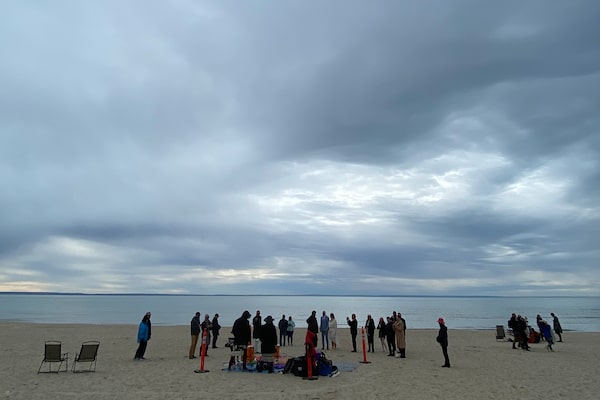
Crystal Beach, west of Fort ErieIvan Semeniuk/The Globe and Mail
I’m at Crystal Beach, west of Fort Erie, Ont. Under cloudy skies and a smattering of rain, a wedding ceremony is under way in advance of this afternoon’s total solar eclipse.
11:35 a.m
Where to see all the total solar eclipses for the rest of this decade
For eclipse chasers, the world is an observatory.
Iceland? Egypt? Australia? All three could be on your destination list in the next few years if you let the moon’s shadow act as your travel planner.
Of course, for many who live in Central and Eastern Canada, today will offer the astronomical chance of a lifetime: seeing a total eclipse of the sun at home, or close to it.
But to whet your appetite, here’s a list of total solar eclipses you can expect over the next 10 years:
- Aug. 12, 2026
- Aug. 2, 2027
- July 22, 2028
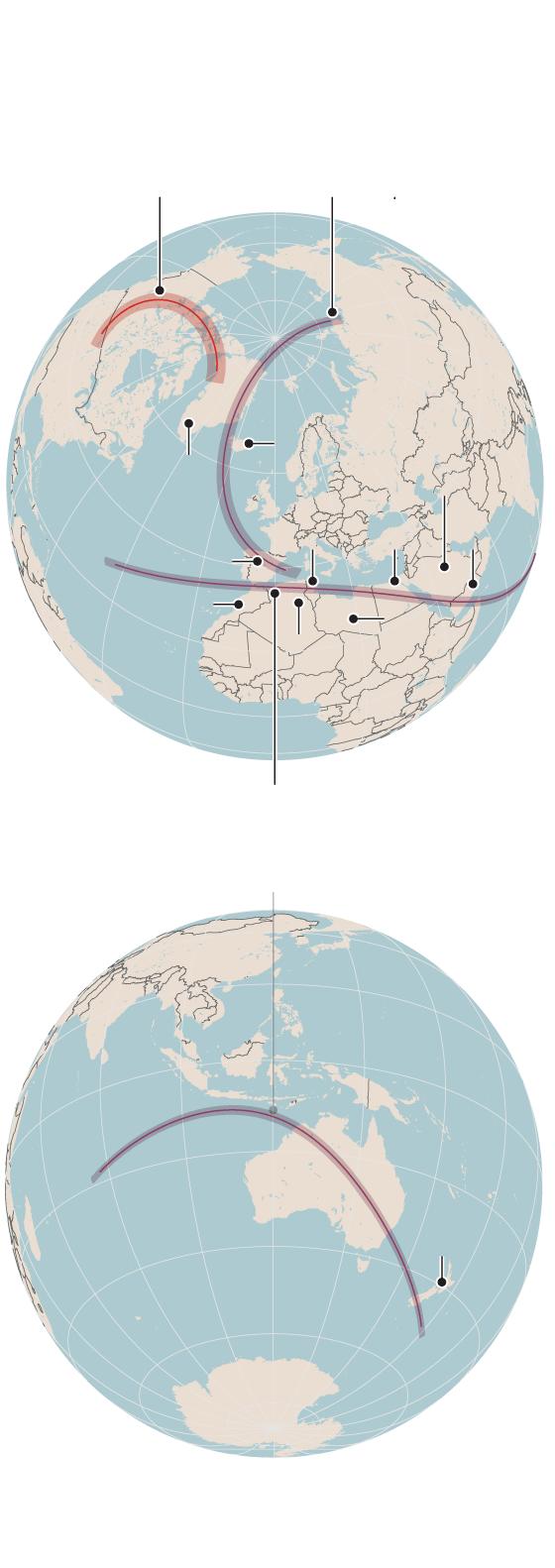
Paths of the next three total solar eclipses after April 8, 2024, plus Canada's next total
Aug. 23, 2044
Aug. 12, 2026
Russia
Canada
Iceland
Greenland
Saudi Arabia
Tunisia
Egypt
Yemen
Spain
Morocco
Libya
Algeria
Aug. 2, 2027
July 22, 2028
Australia
New
Zealand
MURAT YÜKSELIR / THE GLOBE AND MAIL,
SOURCE: TIMEANDDATE.COM
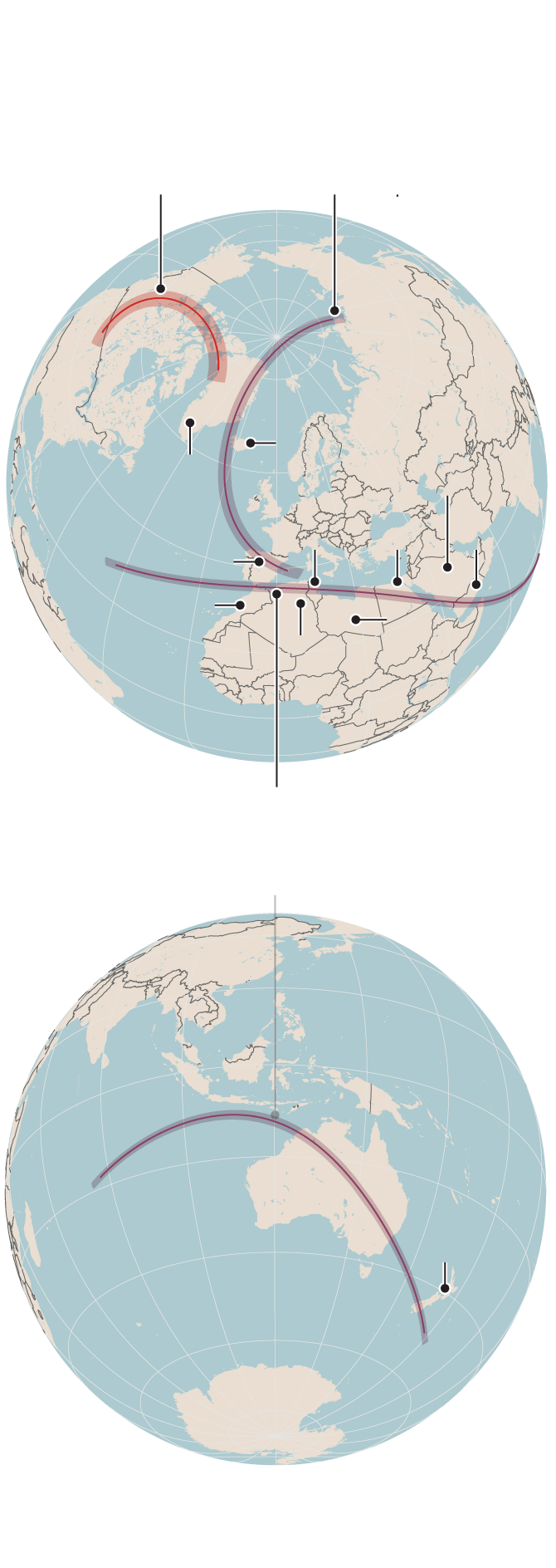
Paths of the next three total solar eclipses after April 8, 2024, plus Canada's next total
Aug. 23, 2044
Aug. 12, 2026
Russia
Canada
Iceland
Greenland
Saudi Arabia
Tunisia
Egypt
Yemen
Spain
Morocco
Libya
Algeria
Aug. 2, 2027
July 22, 2028
Australia
New
Zealand
MURAT YÜKSELIR / THE GLOBE AND MAIL,
SOURCE: TIMEANDDATE.COM
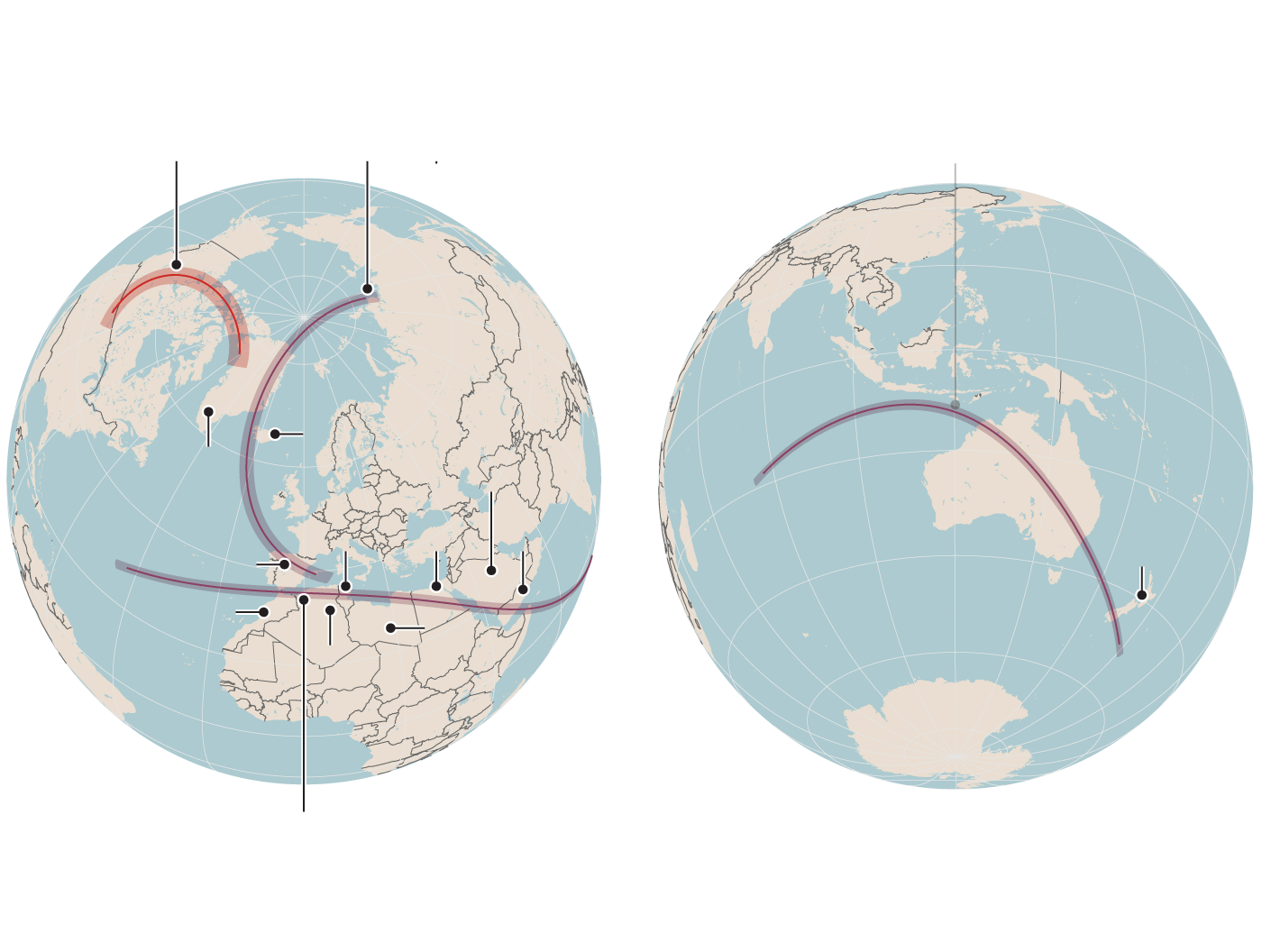
Paths of the next three total solar eclipses after April 8, 2024, plus Canada's next total
Aug. 23, 2044
Aug. 12, 2026
July 22, 2028
Russia
Canada
Iceland
Greenland
Saudi Arabia
Australia
New
Zealand
Tunisia
Egypt
Yemen
Spain
Morocco
Libya
Algeria
Aug. 2, 2027
MURAT YÜKSELIR / THE GLOBE AND MAIL, SOURCE: TIMEANDDATE.COM
What about Canada? Here’s a full guide to the next total solar eclipses you can expect.
11:15 a.m
Watch: How to safely view the eclipse with your kids
From eclipse glasses to pinhole projection, Globe science reporter Ivan Semeniuk explains what parents need to know to enjoy the stellar event with their kids. The eclipse is April 8 and will be visible from a large swath of eastern Canada.
The Globe and Mail
11:12 a.m
Toronto eclipse-catchers in good spirits aboard Niagara GO Train, despite cloudy forecast

Passengers pack an extended GO train and sit in the aisles headed from Union Station in Toronto to Niagara Falls, Ont. to view the solar eclipse on April 8, 2024.Melissa Tait/The Globe and Mail
The 9:02 a.m. GO train from Toronto to Niagara Falls is packed with umbraphiles. Passengers are sitting in the aisles, on stairs and on laps. Some have set up lawn chairs. Everyone is swapping the latest weather updates from their phones. The forecast looks grim, but it hasn’t soured an overall giddiness aboard the cars.
11 a.m
What to expect when you’re expecting a total eclipse
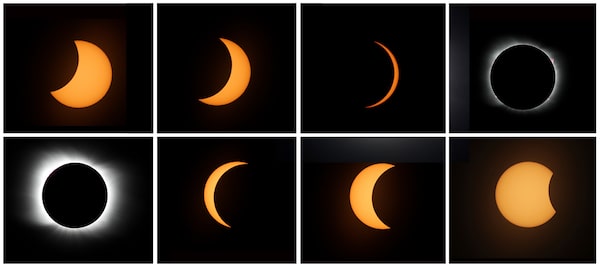
A total solar eclipse is more than just the moon covering the sun; it's a multi-phase spectacle that can cause a number of unusual phenomena, if the weather is right.Natacha Pisarenko/The Canadian Press
It’s not just because they are rare that total eclipses of the sun are so special. They are also downright weird.
Blocking the sun is easy. You can do it with your hat. But when a 3,475-kilometre-wide ball of rock, a.k.a. the moon, does it for you, you get something that is much more than shade.
Various chroniclers have tried to capture what that experience is like. Among the most vivid descriptions from centuries past is one by Greek historian Leo the Deacon, who was a student living in Constantinople when he saw a total eclipse there in the year 968.
“One could see the disk of the sun dark and unlighted, and a dim and faint gleam, like a delicate headband, illuminating the edge of the disk all the way around.” Leo wrote.
Today those words survive as the first unambiguous description of the solar corona, a wispy sheath of ionized particles that can be seen only when the sun’s brilliant surface is entirely obscured by the moon.
The corona takes centre stage while the total eclipse is underway, but it’s not the only thing to look at. The challenge is things start to happen fast as totality approaches. Some eclipse goers pop on headphones to play a self-recording message in sync with the duration of the eclipse that reminds them to look and do certain things at the right time.

Moonshadows: The celestial geometry
behind a total solar eclipse
Sun
Moon
Moon’s
orbit
Partial eclipse
(penumbra)
Total eclipse
(umbra)
Earth
Earth’s
orbit
Partial eclipse
Total eclipse
Corona
*Diagram is not to scale.
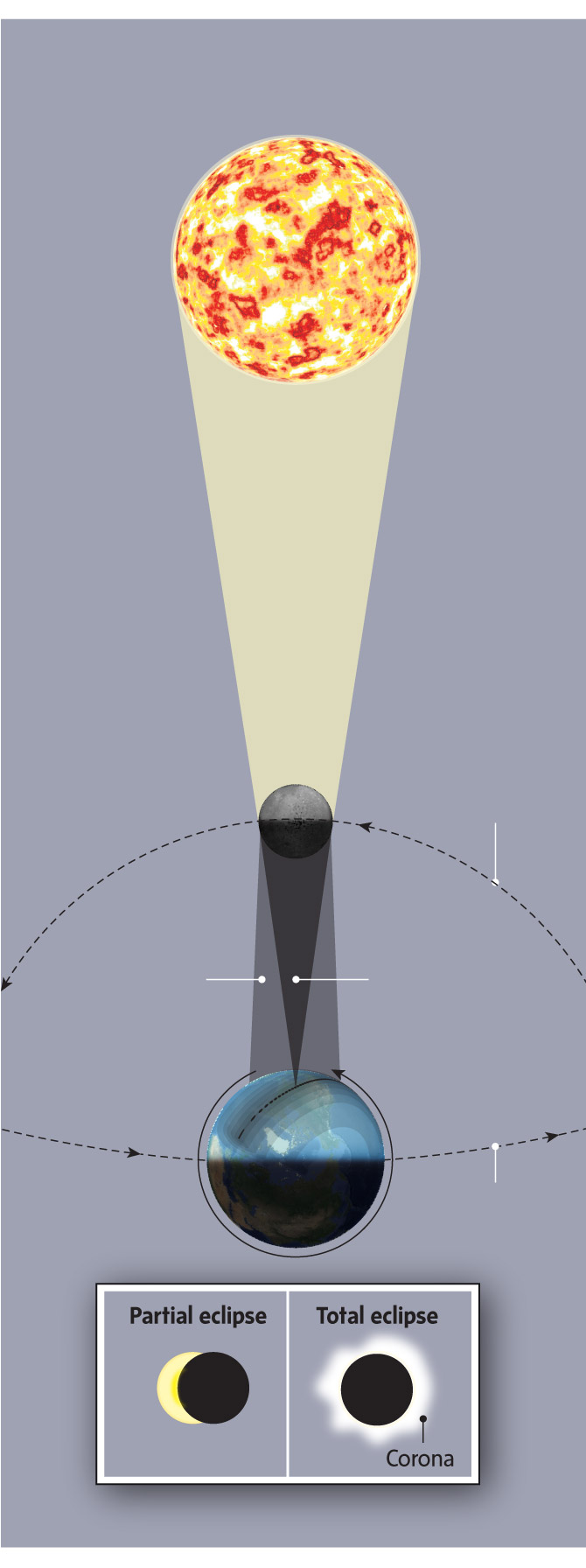
Moonshadows: The celestial geometry
behind a total solar eclipse
Sun
Moon
Moon’s
orbit
Partial eclipse
(penumbra)
Total eclipse
(umbra)
Earth
Earth’s
orbit
Partial eclipse
Total eclipse
Corona
*Diagram is not to scale.
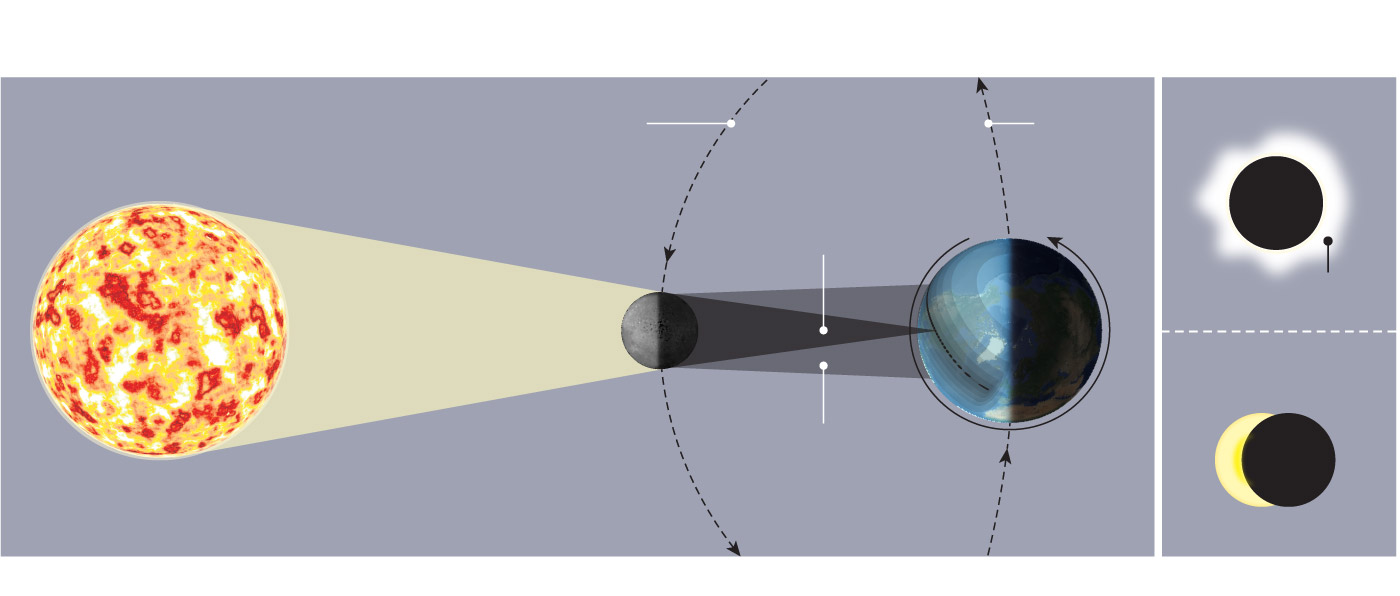
Moonshadows: The celestial geometry behind a total solar eclipse
Total eclipse
Earth’s
orbit
Moon’s
orbit
Total eclipse
(umbra)
Corona
Sun
Moon
Earth
Partial eclipse
Partial eclipse
(penumbra)
*Diagram is not to scale.
Here’s a short list of phenomena to help you get the most out of today’s celestial event.
10:35 a.m.
When will the solar eclipse appear in Vancouver, Calgary and other cities outside the path of totality?
Canadians in cities that aren’t along the path of totality can still experience today’s solar eclipse. Windsor, Ont, Toronto, Charlottetown and St. John’s will see 99 per cent of the sun covered. Even cities on the West Coast will experience some sun coverage throughout the day.
– Globe staff
10 a.m.
Canadians cross their fingers for clear skies
Millions of people planning to watch today’s solar eclipse may find themselves disappointed – or delighted – by a classic Canadian wildcard: weather.
The forecast varies across the eclipse’s path through the country, but meteorologists are anticipating overcast skies over much of Ontario, which would diminish the eclipse’s effect in Canada’s most populous province.
The path of totality – the band where the moon will fully block the sun, plunging day into darkness for up to four minutes – stretches from Southern Ontario to the eastern tip of Newfoundland.
“April is not the best time to view an eclipse. In Canada, it is usually a cloudy month,” said Dave Phillips, a senior climatologist with Environment Canada. Still, he advised people to seize the opportunity to be part of the historic event if they can, clear skies or not.
Meanwhile, after a string of grey days and snow, the forecast as of Sunday evening in New Brunswick was looking warm and clear, making it, as Miramichi Mayor Adam Lordon was happy to point out, possibly one of the best eclipse viewing spots in North America.
Monday’s celestial event will be the first total solar eclipse visible in broadly populated areas of Canada since 1979. (In 2008, a solar eclipse passed over parts of Nunavut.)
Will the weather affect the view of the eclipse? Check out the forecast for Canadian cities on the path of totality.
– Jana G. Pruden and Colin Freeze
10 a.m.
How to watch the total solar eclipse
The track of the total eclipse of the sun includes some of the most populated regions of the country.
Factors such as weather and traffic will be in play for those aiming to see the event. If you live outside the path of totality, the key question will be where to go to see it best. Whatever the answer, expect traffic. Based on what happened in the United States during a total eclipse in 2017, roads that lead into the path of totality will be jammed before and after the event – potentially for many hours.
Here are the details you need to make the most of the event.
Editor’s note: This article has been updated to clarify that during Monday's total eclipse, the moon moved between the sun and earth.










